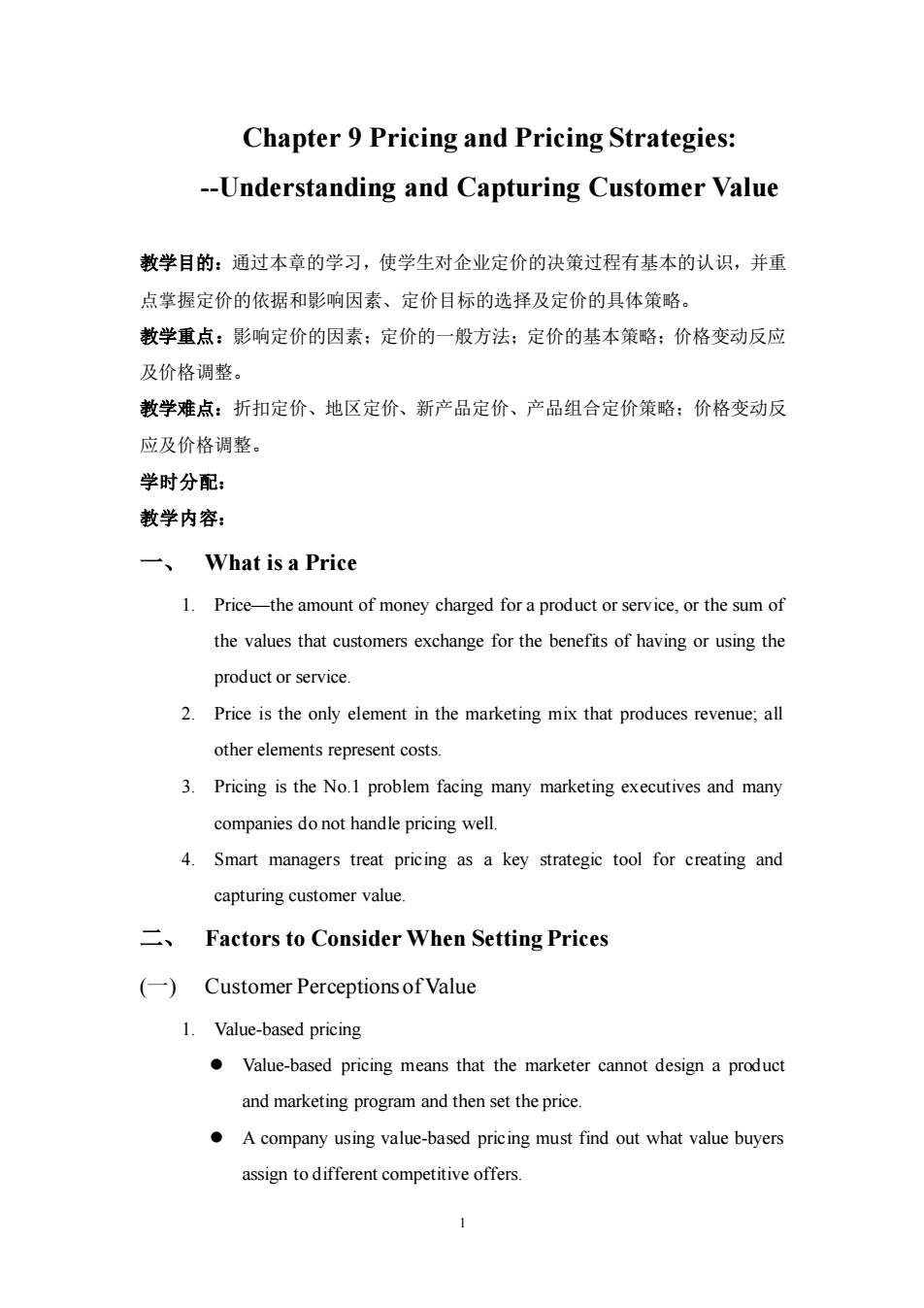
Chapter 9 Pricing and Pricing Strategies: -Understanding and Capturing Customer Value 教学目的:通过本章的学习,使学生对企业定价的决策过程有基本的认识,并重 点掌握定价的依据和影响因素、定价目标的选择及定价的具体策略。 教学重点:影响定价的因素:定价的一般方法:定价的基本策略;价格变动反应 及价格调整 教学难点:折扣定价、地区定价、新产品定价、产品组合定价策略:价格变动反 应及价格调整。 学时分配: 教学内容: 一、What is a Price 1.Price-the amount of money charged for a product or service.or the sum of the values that customers exchange for the benefits of having or using the product or service 2.Price is the only element in the marketing mix that produces revenue;all other elements represent costs. 3.Pricing is the No.I problem facing many marketing executives and many companies do not handle pricing well. 4.Smart managers treat pricing as a key strategic tool for creating and capturing customer value 二、 Factors to Consider When Setting Prices (-)Customer Perceptions of Value 1.Value-based pricing Value-based pricing means that the marketer cannot design a product and marketing program and then set the price. A company using value-based pricing must find out what value buyers assign to different competitive offers
1 Chapter 9 Pricing and Pricing Strategies: -Understanding and Capturing Customer Value 教学目的:通过本章的学习,使学生对企业定价的决策过程有基本的认识,并重 点掌握定价的依据和影响因素、定价目标的选择及定价的具体策略。 教学重点:影响定价的因素;定价的一般方法;定价的基本策略;价格变动反应 及价格调整。 教学难点:折扣定价、地区定价、新产品定价、产品组合定价策略;价格变动反 应及价格调整。 学时分配: 教学内容: 一、 What is a Price 1. Price—the amount of money charged for a product or service, or the sum of the values that customers exchange for the benefits of having or using the product or service. 2. Price is the only element in the marketing mix that produces revenue; all other elements represent costs. 3. Pricing is the No.1 problem facing many marketing executives and many companies do not handle pricing well. 4. Smart managers treat pricing as a key strategic tool for creating and capturing customer value. 二、 Factors to Consider When Setting Prices (一) Customer Perceptions of Value 1. Value-based pricing ⚫ Value-based pricing means that the marketer cannot design a product and marketing program and then set the price. ⚫ A company using value-based pricing must find out what value buyers assign to different competitive offers
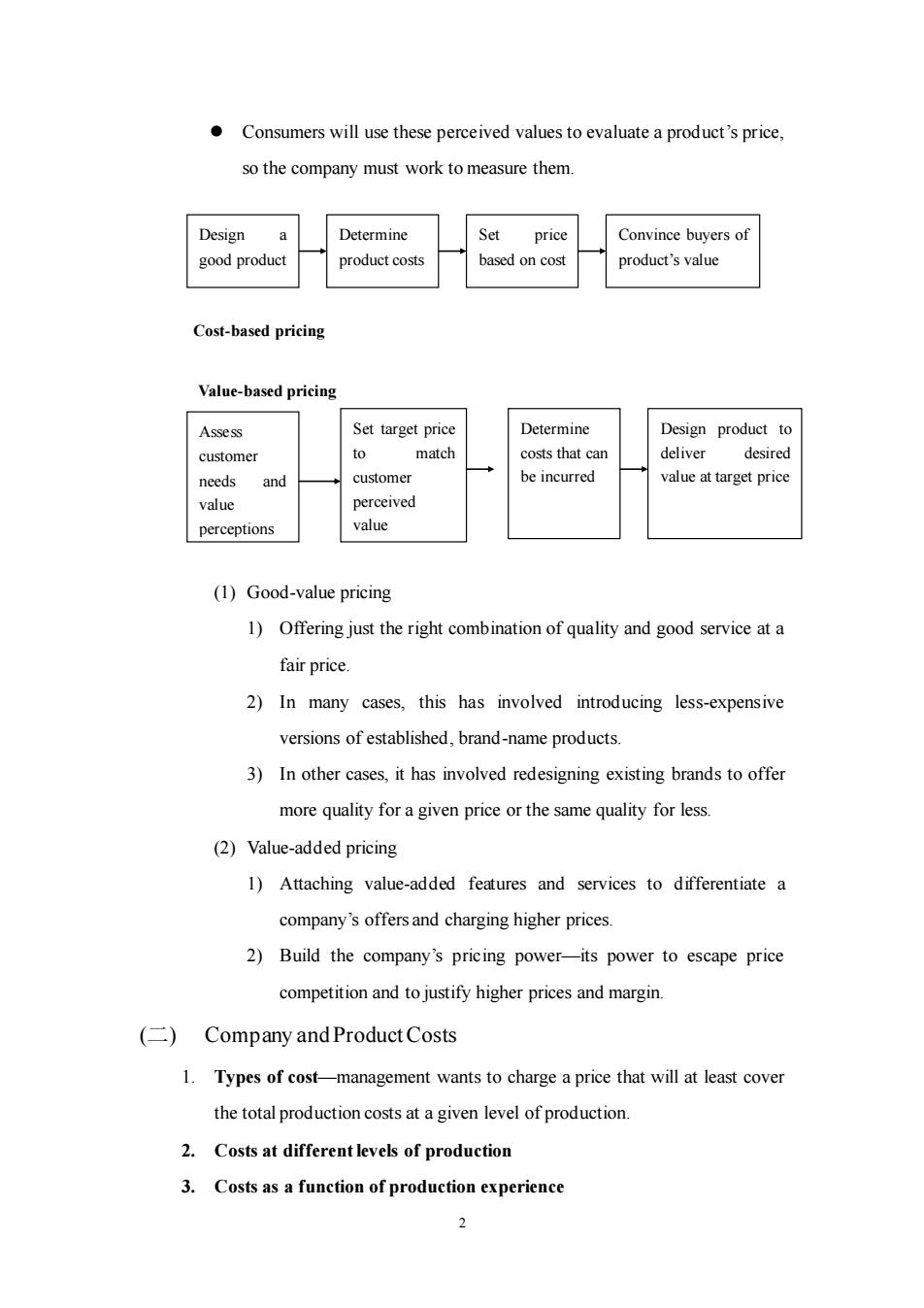
Consumers will use these perceived values to evaluate a product's price. so the company must work to measure them. Design Determine Set price Convince buyers of good produc product costs based on co product's value Cost-based pricing Value-based pricing Assess Set target pric Determine Design product to customer 0 matcl costs that can deliver desired customer be incurred value at target price perceptions (1)Good-value pricing 1)Offering just the right combination of quality and good service at a fair price. 2)In many cases,this has involved introducing less-expensive versions of established,brand-name products 3)In other cases,it has involved redesigning existing brands to offer more quality for a given price or the same quality for less. (2)Value-added pricing 1)Attaching value-added features and services to differentiate a company's offers and charging higher prices. 2)Build the company's pricing power-its power to escape price competition and tojustify higher prices and margin ()Company and Product Costs 1.Types of cost-management wants to charge a price that will at least cover the total production costs at a given level of production. 2.Costs at different levels of production 3.Costs as a function of production experience
2 ⚫ Consumers will use these perceived values to evaluate a product’s price, so the company must work to measure them. (1) Good-value pricing 1) Offering just the right combination of quality and good service at a fair price. 2) In many cases, this has involved introducing less-expensive versions of established, brand-name products. 3) In other cases, it has involved redesigning existing brands to offer more quality for a given price or the same quality for less. (2) Value-added pricing 1) Attaching value-added features and services to differentiate a company’s offers and charging higher prices. 2) Build the company’s pricing power—its power to escape price competition and to justify higher prices and margin. (二) Company and Product Costs 1. Types of cost—management wants to charge a price that will at least cover the total production costs at a given level of production. 2. Costs at different levels of production 3. Costs as a function of production experience Design a good product Determine product costs Set price based on cost Convince buyers of product’s value Cost-based pricing Assess customer needs and value perceptions Set target price to match customer perceived value Determine costs that can be incurred Design product to deliver desired value at target price Value-based pricing
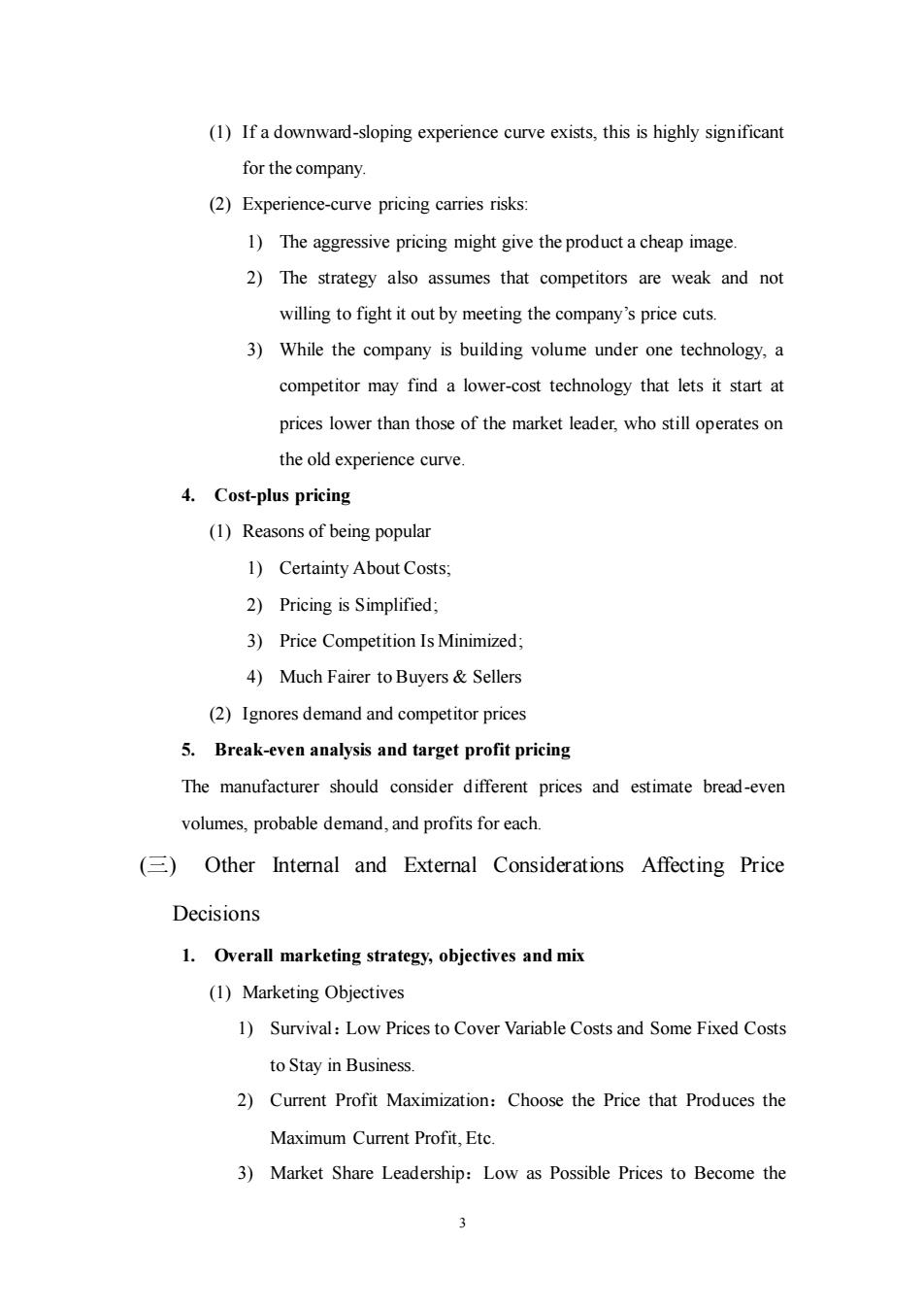
(1)If a downward-sloping experience curve exists,this is highly significant for the company. (2)Experience-curve pricing carries risks: 1)The aggressive pricing might give the product a cheap image 2)The strategy also assumes that competitors are weak and not willing to fight it out by meeting the company's price cuts. 3)While the company is building volume under one technology,a competitor may find a lower-cost technology that lets it start at prices lower than those of the market leader,who still operates on the old experience curve 4.Cost-plus pricing (1)Reasons of being popular 1)Certainty About Costs: 2)Pricing is Simplified: 3)Price Competition Is Minimized 4)Much Fairer to Buyers&Sellers (2)Ignores demand and competitor prices 5.Break-even analysis and target profit pricing The manufacturer should consider different prices and estimate bread-even volumes,probable demand,and profits for each. ()Other Internal and External Considerations Affecting Price Decisions 1.Overall marketing strategy,objectives and mix (1)Marketing Objectives 1)Survival:Low Prices to Cover Variable Costs and Some Fixed Costs to Stay in Business. 2)Current Profit Maximization:Choose the Price that Produces the Maximum Current Profit,Etc 3)Market Share Leadership:Low as Possible Prices to Become the 3
3 (1) If a downward-sloping experience curve exists, this is highly significant for the company. (2) Experience-curve pricing carries risks: 1) The aggressive pricing might give the product a cheap image. 2) The strategy also assumes that competitors are weak and not willing to fight it out by meeting the company’s price cuts. 3) While the company is building volume under one technology, a competitor may find a lower-cost technology that lets it start at prices lower than those of the market leader, who still operates on the old experience curve. 4. Cost-plus pricing (1) Reasons of being popular 1) Certainty About Costs; 2) Pricing is Simplified; 3) Price Competition Is Minimized; 4) Much Fairer to Buyers & Sellers (2) Ignores demand and competitor prices 5. Break-even analysis and target profit pricing The manufacturer should consider different prices and estimate bread-even volumes, probable demand, and profits for each. (三) Other Internal and External Considerations Affecting Price Decisions 1. Overall marketing strategy, objectives and mix (1) Marketing Objectives 1) Survival:Low Prices to Cover Variable Costs and Some Fixed Costs to Stay in Business. 2) Current Profit Maximization:Choose the Price that Produces the Maximum Current Profit, Etc. 3) Market Share Leadership:Low as Possible Prices to Become the
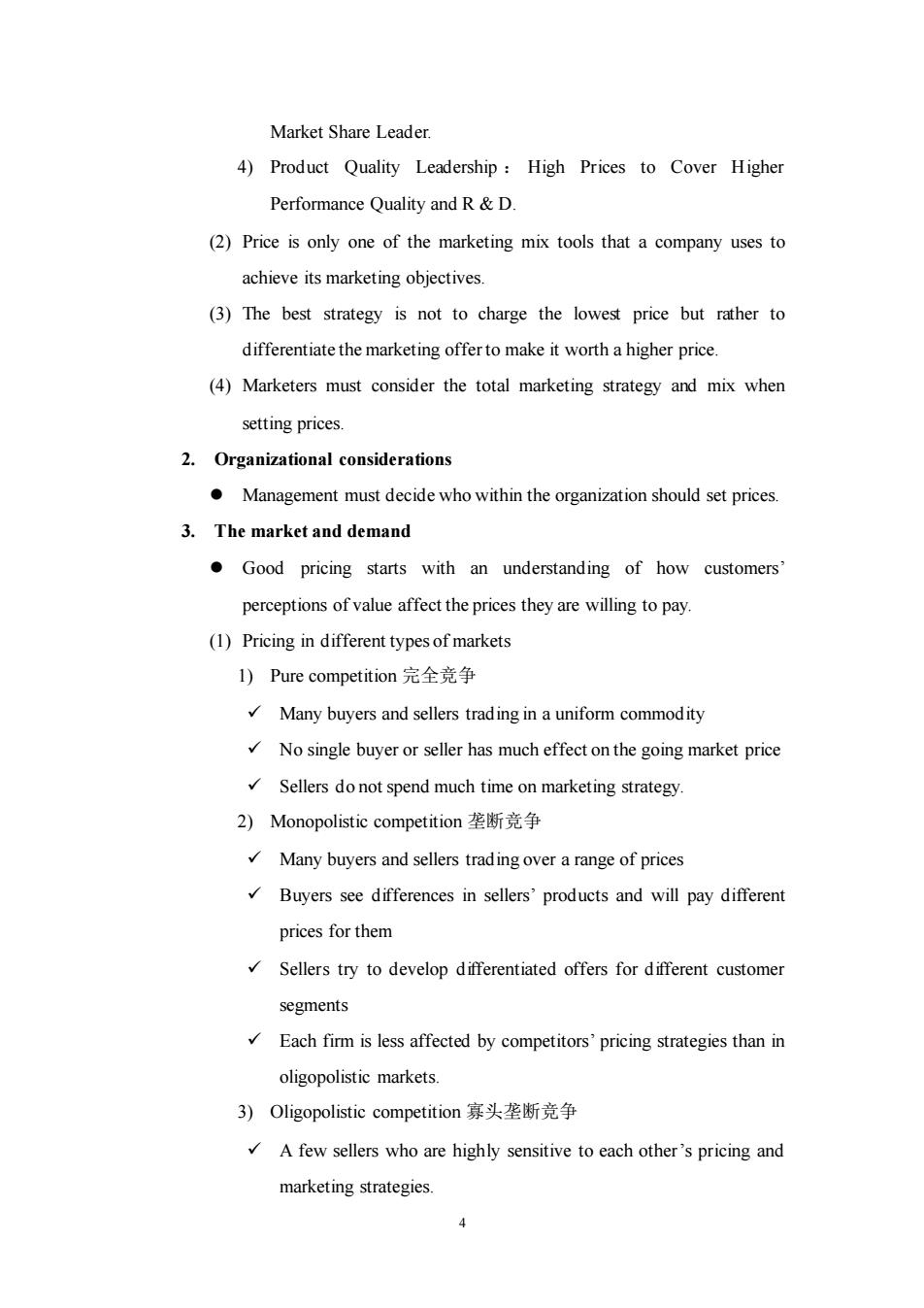
Market Share Leader. 4)Product Quality Leadership:High Prices to Cover Higher Performance Quality and R&D. (2)Price is only one of the marketing mix tools that a company uses to achieve its marketing objectives. (3)The best strategy is not to charge the lowest price but rather to differentiate the marketing offer to make it worth a higher price (4)Marketers must consider the total marketing strategy and mix when setting prices 2.Organizational considerations Management must decide who within the organization should set prices. 3.The market and demand Good pricing starts with an understanding of how customers perceptions of value affect the prices they are willing to pay (1)Pricing in different types of markets 1)Pure competition完全竞争 Many buyers and sellers trading in a uniform commodity No single buyer or seller has much effect on the going market price Sellers donot spend much time on marketing strategy. 2)Monopolistic competition垄断竞争 Many buyers and sellers tradingover a range of prices Buyers see differences in sellers'products and will pay different prices for them Sellers try to develop differentiated offers for different customer segments Each firm is less affected by competitors'pricing strategies than in oligopolistic markets. 3)Oligopolistic competition寡头垄断竞争 A few sellers who are highly sensitive to each other's pricing and marketing strategies
4 Market Share Leader. 4) Product Quality Leadership : High Prices to Cover Higher Performance Quality and R & D. (2) Price is only one of the marketing mix tools that a company uses to achieve its marketing objectives. (3) The best strategy is not to charge the lowest price but rather to differentiate the marketing offer to make it worth a higher price. (4) Marketers must consider the total marketing strategy and mix when setting prices. 2. Organizational considerations ⚫ Management must decide who within the organization should set prices. 3. The market and demand ⚫ Good pricing starts with an understanding of how customers’ perceptions of value affect the prices they are willing to pay. (1) Pricing in different types of markets 1) Pure competition 完全竞争 ✓ Many buyers and sellers trading in a uniform commodity ✓ No single buyer or seller has much effect on the going market price ✓ Sellers do not spend much time on marketing strategy. 2) Monopolistic competition 垄断竞争 ✓ Many buyers and sellers trading over a range of prices ✓ Buyers see differences in sellers’ products and will pay different prices for them ✓ Sellers try to develop differentiated offers for different customer segments ✓ Each firm is less affected by competitors’ pricing strategies than in oligopolistic markets. 3) Oligopolistic competition 寡头垄断竞争 ✓ A few sellers who are highly sensitive to each other’s pricing and marketing strategies
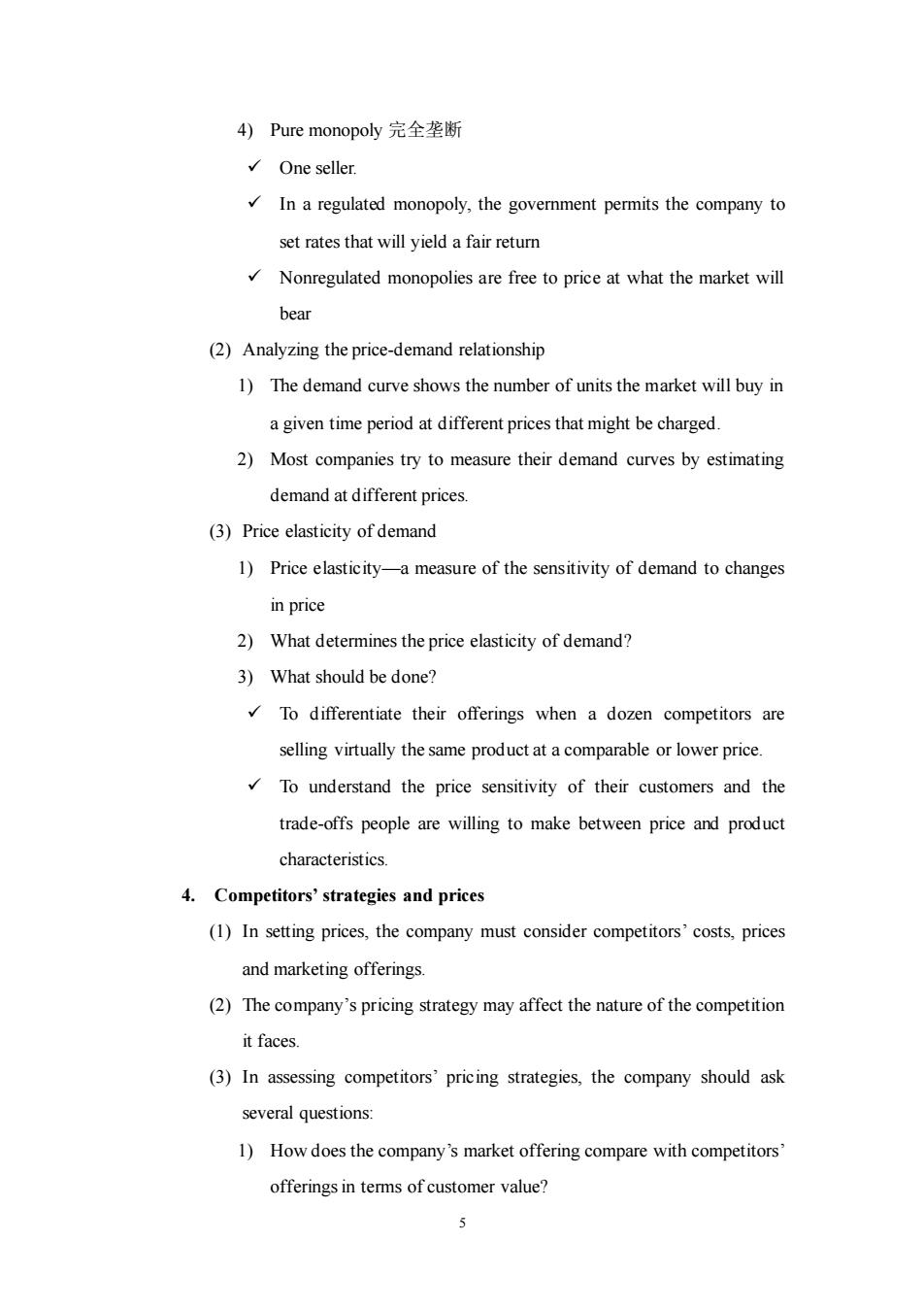
4)Pure monopoly完全垄断 √One seller. In a regulated monopoly,the government permits the company to set rates that will yield a fair retur Nonregulated monopolies are free to price at what the market will bear (2)Analyzing the price-demand relationship 1)The demand curve shows the number of units the market will buy in a given time period at different prices that might be charged. 2)Most companies try to measure their demand curves by estimating demand at different prices (3)Price elasticity of demand 1)Price elasticity-a measure of the sensitivity of demand to changes in price 2)What determines the price elasticity of demand? 3)What should be done? To differentiate their offerings when a dozen competitors are selling virtually the same product at a comparable or lower price. To understand the price sensitivity of their customers and the trade-offs people are willing to make between price and product characteristics 4.Competitors'strategies and prices (1)In setting prices,the company must consider competitors'costs,prices and marketing offerings. (2)The company's pricing strategy may affect the nature of the competition it faces. (3)In assessing competitors'pricing strategies,the company should ask several questions: 1)How does the company's market offering compare with competitors offerings in terms of customer value?
5 4) Pure monopoly 完全垄断 ✓ One seller. ✓ In a regulated monopoly, the government permits the company to set rates that will yield a fair return ✓ Nonregulated monopolies are free to price at what the market will bear (2) Analyzing the price-demand relationship 1) The demand curve shows the number of units the market will buy in a given time period at different prices that might be charged. 2) Most companies try to measure their demand curves by estimating demand at different prices. (3) Price elasticity of demand 1) Price elasticity—a measure of the sensitivity of demand to changes in price 2) What determines the price elasticity of demand? 3) What should be done? ✓ To differentiate their offerings when a dozen competitors are selling virtually the same product at a comparable or lower price. ✓ To understand the price sensitivity of their customers and the trade-offs people are willing to make between price and product characteristics. 4. Competitors’ strategies and prices (1) In setting prices, the company must consider competitors’ costs, prices and marketing offerings. (2) The company’s pricing strategy may affect the nature of the competition it faces. (3) In assessing competitors’ pricing strategies, the company should ask several questions: 1) How does the company’s market offering compare with competitors’ offerings in terms of customer value?